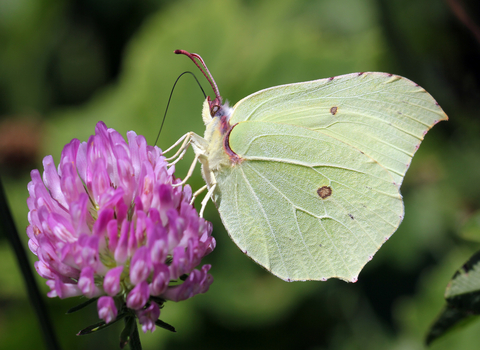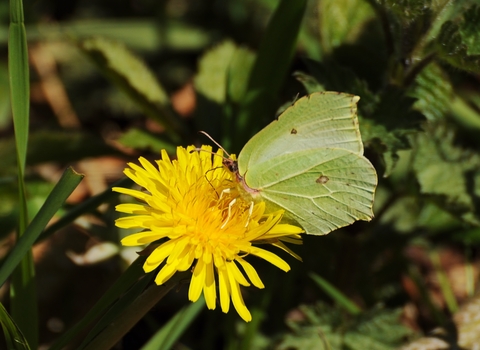
Brimstone ©Jim Higham
Brimstone
Scientific name
Gonepteryx rhamniWhen to see
January to DecemberSpecies information
Category
Statistics
Wingspan: 6.0-7.4cmAbout
The brimstone is a fairly large, pale yellow butterfly, with distinctive, leaf-shaped wings. Adults hibernate through cold weather, so may be seen flying on warm days throughout the year, although they are most common in the spring. Usually seen in ones or twos, they are never very common, but are widespread. They can be found in damp woodlands, along sunny, woodland rides and mature hedgerows, and in large gardens. The foodplants of the larvae are buckthorn and alder buckthorn. Both shrubs are found in wet woodland, while buckthorn also occurs on dry chalk and limestone soils.How to identify
The brimstone is a large butterfly with a greyish body and characteristically veiny and pointed wings. Males are lemon-yellow, while females are greenish-white with orange spots in the middle of each wing. Brimstones rest with their wings closed.Distribution
Found across most of England, Wales and Ireland.In our area
Brimstone butterflies are commonly found across Shropshire, but particularly where plant species such as Alder Buckthorn are found as this is an important food source for caterpillars. Alder Buckthorn is particularly prevalent on the Mosses in North Shropshire.
In the spring when butterflies emerge out of hibernation they will search for nectar from early flowering plants, such as primrose, pussywillow and ivy.
Did you know?
It is thought that the bright yellow colour of the male brimstone's wings inspired the name 'butter-fly'.Watch
Brimstone (https://vimeo.com/473835629/4ad1ca40f2)
Brimstone butterfly © Tom Hibbert
Brimstone butterflies are commonly found across Shropshire, but particularly where plant species such as Alder Buckthorn are found as this is an important food source for caterpillars. Alder Buckthorn is particularly prevalent on the Mosses in North Shropshire.
In the spring when butterflies emerge out of hibernation they will search for nectar from early flowering plants, such as primrose, pussywillow and ivy.

